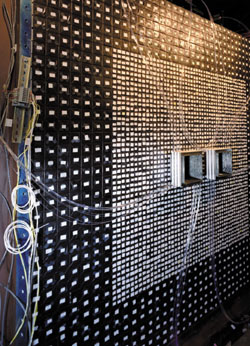
New data from the KTeV experiment at Fermilab blow away some of the fog around the mystery of CP violation and underline the effects suggested by earlier results from CERN. It is now clearly established that CP is violated in the way the six known quarks decay and transform into each other.
In 1956, physicists were shocked to discover that the weak force is sensitive to direction and can differentiate left from right. With theoretical foundations crumbling, physicists proposed a new girder to support their theories: this time the combined CP symmetry mirror that changes particles to antiparticles as it reflects from left to right. In the CP mirror, a right-handed particle reflects as a left-handed antiparticle, and vice versa.
If CP symmetry is good, the neutral kaon should exist in two forms: a longlived one decaying into three pions, and a shortlived one decaying into two pions. In 1964, physicists received another shock when they found that, in the decays of the neutral kaon, CP too is violated. Longlived kaons can decay into two pions.
There are two possible explanations for this CP violation. The longlived kaon could be a mixture of two states that are even and odd under CP reflection. This has long been known to be the case: the even-CP state can decay into two pions and introduce a CP-violating component for the longlived kaon.
The other possibility, called direct CP violation, is that the CP-odd state decays directly into the “forbidden” two pion mode.
What causes the kaon states to mix CP? Using the six known quarks, this can be accommodated in the quark transformations, which subtly rearrange the incoming and outgoing quark configurations, switching a neutral kaon to its antiparticle. However, CP mixing could also be due to kaons transforming into each other via some other mechanism. In this case, direct CP violation CP violation in the decay process would not be possible.
To unravel these two alternatives demands the careful measurement of direct CP violation via the “ratio of ratios”: the ratio of longlived kaons decaying into two neutral pions to those going into two charged pions,
divided by the same ratio for shortlived kaons. If this ratio of ratios turns out to be different from one, this demonstrates that quark transformations are responsible for CP violation.
For several years the two main experiments NA31 at CERN and E731 at Fermilab begged to differ, the former giving the difference of the ratio from unity (divided by a numerical factor) of 2.3 ±0.65 x 10-3, and the latter giving a much smaller figure, compatible with zero. Physicists held their breath.
Now the KTeV experiment, using 20% of its data collected in 1996 and 1997, comes in at 2.8 ±0.41 x 10-3, in tune with the earlier CERN figure, but slightly higher. CP would appear to be violated directly in the decay process in such a way that quark mechanisms contribute.
Meanwhile, the big NA48 next-generation CERN study has been collecting data and will be the next to report. Some 35 years after its discovery, CP violation remains a mystery, but at least the mystery is gradually becoming clearer. The new result is good news for new experiments setting out to measure CP violation using B particles, containing the fifth, “beauty”, or “b”, quark, where the levels of CP violation are now expected to be much higher than those using neutral kaons.





